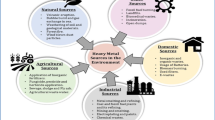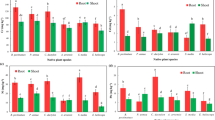Abstract
Paspalum distichum L. was tested to evaluate their phytoremediation capacity for Hg contaminated soil through analyzing the dissipation of Hg in soil through a greenhouse study by using self-made rhizos box. Original soil samples were collected at Hg mining site with serious Hg contamination and a control site, respectively. Planting of P. distichum. L last for 60 days. Soil and plant samples were collected from four periods (0 d, 20 d, 40 d, and 60 d) and soil samples were collected from five different rhizosphere distance in horizontal direction (0–2 cm, 2–4cm, 4–6cm, 6–8cm, 8–10cm). The results showed that the presence of P. distichum. L significantly accelerated the Hg dissipation in soil compared with control. Hg concentration in the rhizospheric soil was affected by the plant growth period and the distance to the plant roots. The closer of soil to the root of P. distichum. L, the lower mercury concentration in soil. During the 60-day growing period, the concentrations of total Hg (THg) and methylmercury (MeHg) reduced by 45% and 64%, respectively, in the rhizosphere (0–2cm) of Hg contaminated soil. However, MeHg concentration was increased near the roots (0–4 cm) during the initial growing period (0–20 d), which may be attributed to the influence of root exudates. Root is the major part for Hg accumulation in P. distichum. L. The low ratio between Hg concentrations in underground and aboveground tissues indicated that it seemed difficult for Hg translocation from root to shoot. The highest THg (9.71 ± 3.09 μg·g-1) and MeHg (26.97 ± 0.98 ng·g-1) value in root of P. distichum. L were observed at the 20th day when P. distichum. L grown in Hg contaminated soil. The results of chemical fractions analyses showed that elemental Hg and residual Hg were the two major speciations followed by organic bound Hg in the Hg contaminated soil, which indicated the high bioavailability and ecological potential risk of Hg in Hg contaminated soil.




Similar content being viewed by others
References
Abhilash PC, Jamil S, Singh V, Singh A, Singh N, Srivastava SC (2008) Occurrence and distribution of hexachlorocyclohexane isomers in vegetation samples from a contaminated area. Chemosphere 72:79–86
Ahkami AH, Allen White R, Handakumbura PP, Jansson C (2017) Rhizosphere engineering: enhancing sustainable plant ecosystem productivity. Rhizosphere 3:233–243
Alcantara R, Fernandez P, Smeda RJ, Alves PL, De Prado R (2016) Response of Eleusine indica and Paspalum distichum to glyphosate following repeated use in citrus groves. Crop Prot 79:1–7
Anning AK, Korsah PE, Addo-Fordjour P (2013) Phytoremediation of Wastewater with Limnocharis Flava, Thalia Geniculata and Typha Latifolia in Constructed Wetlands. Int J Phytoremediat 15:452–464
Ashraf S, Ali Q, Zahir ZA, Ashraf S, Asghar HN (2019) Phytoremediation: environmentally sustainable way for reclamation of heavy metal polluted soils. Ecotox Environ Safe 174:714–727
Bloom N, Fitzgerald WF (1988) Determination of volatile mercury species at the picogram level by low-temperature gas chromatography with cold-vapour atomic fluorescence detection. Anal Chim Acta 208:151–161
Bloom NS, Preus E, Katon J, Hiltner M (2003) Selective extractions to assess the biogeochemically relevant fractionation of inorganic mercury in sediments and soils. Anal Chim Acta 479:233–248
Castro R, Pereira S, Lima A, Corticeiro S, Válega M, Pereira E, Duarte A, Figueira E (2009) Accumulation, distribution and cellular partitioning of mercury in several halophytes of a contaminated salt marsh. Chemosphere 76:1348–1355
Feng X, Qiu G (2008) Mercury pollution in Guizhou, Southwestern China—an overview. Sci Total Environ 400:227–237
Fitzgerald WF, Engstrom DR, Mason RP, Nater EA (1998) The Case for Atmospheric Mercury Contamination in Remote Areas. Environ Sci Technol 32:1–7
Gomes MADC, Hauser-Davis RA, De Souza AN, Vitória AP (2016) Metal phytoremediation: general strategies, genetically modified plants and applications in metal nanoparticle contamination. Ecotox Environ Safe 134:133–147
Greger M, Wang Y, Neuschütz C (2005) Absence of Hg transpiration by shoot after Hg uptake by roots of six terrestrial plant species. Environ Pollut 134:201–208
Lei P, Zhong H, Duan D, Pan K (2019) A review on mercury biogeochemistry in mangrove sediments: hotspots of methylmercury production? Sci Total Environ 680:140–150
Li P, Feng X, Qiu G, Shang L, Wang S (2012) Mercury pollution in Wuchuan mercury mining area, Guizhou, Southwestern China: the impacts from large scale and artisanal mercury mining. Environ Int 42:59–66
Liang L, Horvat M, Bloom NS (1994) An improved speciation method for mercury by GC/CVAFS after aqueous phase ethylation and room temperature precollection. Talanta 41:371–379
Liang L, Evens C, Lazoff S, Woods JS, Cernichiari E, Horvat M, Martin MD, DeRouen T (2000) Determination of Methyl Mercury in Whole Blood by Ethylation-GC-CVAFS after Alkaline Digestion-Solvent Extraction. J Anal Toxicol 24:328–332
Liang P, Feng X, You Q, Zhang J, Cao Y, Leung AOW, Wu S (2016) Mercury speciation, distribution, and bioaccumulation in a river catchment impacted by compact fluorescent lamp manufactures. Environ Sci Pollut R 23:10903–10910
Lominchar MA, Sierra MJ, Millán R (2015) Accumulation of mercury in Typha domingensis under field conditions. Chemosphere 119:994–999
Lomonte C, Doronila AI, Gregory D, Baker AJM, Kolev SD (2010) Phytotoxicity of biosolids and screening of selected plant species with potential for mercury phytoextraction. J Hazard Mater 173:494–501
Marrugo-Negrete J, Durango-Hernández J, Pinedo-Hernández J, Olivero-Verbel J, Díez S (2015) Phytoremediation of mercury-contaminated soils by Jatropha curcas. Chemosphere 127:58–63
Meng B, Feng X, Qiu G, Liang P, Li P, Chen C, Shang L (2011) The Process of Methylmercury Accumulation in Rice (Oryza sativa L.). Environ Sci Technol 45:2711–2717
Natasha SM, Khalid S, Bibi I, Bundschuh J, Niazi K, N. and Dumat, C. (2020) A critical review of mercury speciation, bioavailability, toxicity and detoxification in soil-plant environment: ecotoxicology and health risk assessment. Sci Total Environ 711:134749
Obrist D, Kirk JL, Zhang L, Sunderland EM, Jiskra M, Selin NE (2018) A review of global environmental mercury processes in response to human and natural perturbations: changes of emissions, climate, and land use. Ambio 47:116–140
O'Connor D, Hou D, Ok YS, Mulder J, Duan L, Wu Q, Wang S, Tack FMG, Rinklebe J (2019) Mercury speciation, transformation, and transportation in soils, atmospheric flux, and implications for risk management: a critical review. Environ Int 126:747–761
Qiu G, Feng X, Wang S, Fu X, Shang L (2009) Mercury distribution and speciation in water and fish from abandoned Hg mines in Wanshan, Guizhou province, China. Sci Total Environ 407:5162–5168
Shu WS, Ye ZH, Lan CY, Zhang ZQ, Wong MH (2002) Lead, zinc and copper accumulation and tolerance in populations of Paspalum distichum and Cynodon dactylon. Environ Pollut 120:445–453
Subasinghe R, Soto D, Jia J (2009) Global aquaculture and its role in sustainable development. Rev Aquac 1:2–9
Wang L, Hou D, Cao Y, Ok YS, Tack FMG, Rinklebe J, O'Connor D (2020) Remediation of mercury contaminated soil, water, and air: a review of emerging materials and innovative technologies. Environ Int 134:105281
Yin R, Zhang W, Sun G, Feng Z, Hurley JP, Yang L, Shang L, Feng X (2017) Mercury risk in poultry in the Wanshan Mercury Mine, China. EnvironPollut 230:810–816
Yin D, Wang Y, Xiang Y, Xu Q, Xie Q, Zhang C, Liu J, Wang D (2020) Production and migration of methylmercury in water-level-fluctuating zone of the Three Gorges Reservoir, China: dual roles of flooding-tolerant perennial herb. J Hazard Mater 381:120962
Zhang J, Wu S, Xu Z, Wang M, Man YB, Christie P, Liang P, Shan S, Wong MH (2019) The role of sewage sludge biochar in methylmercury formation and accumulation in rice. Chemosphere 218:527–533
Acknowledgements
Financial support from the Natural Science Foundation of Zhejiang Province (No. LY21D030001) and the National Natural Science Foundation of China (No. 21677131).
Availability of data and materials
All data generated or analyzed during this study are included in this manuscript and its supplementary information files.
Funding
Financial support from the Natural Science Foundation of Zhejiang Province (No. LY21D030001) and the National Natural Science Foundation of China (No. 21677131).
Author information
Authors and Affiliations
Contributions
Su Xu, Ping Gong, and Wen Ding analyzed and interpreted the data regarding this experiment. Shengchun Wu, Xinwei Yu, and Peng Liang performed the explanation of the results. All authors read and approved the final manuscript.
Corresponding authors
Ethics declarations
Ethical approval
Samples of this study only including soil and plant. Therefore, this manuscript did not require the ethical approval.
Consent to participate
Not applicable.
Competing interests
The authors declare that they have no competing interests.
Additional information
Responsible Editor: Elena Maestri
Publisher’s note
Springer Nature remains neutral with regard to jurisdictional claims in published maps and institutional affiliations.
Supplementary Information
ESM 1
(DOCX 216 kb)
Rights and permissions
About this article
Cite this article
Xu, S., Gong, P., Ding, W. et al. Mercury uptake by Paspalum distichum L. in relation to the mercury distribution pattern in rhizosphere soil. Environ Sci Pollut Res 28, 66990–66997 (2021). https://doi.org/10.1007/s11356-021-15093-w
Received:
Accepted:
Published:
Issue Date:
DOI: https://doi.org/10.1007/s11356-021-15093-w




